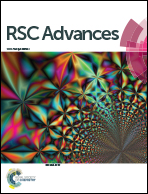Turn-on-type emission enhancement and ratiometric emission color change based on the combination effect of aggregation and TICT found in the hexaazatriphenylene-triphenylamine dye in an aqueous environment†
Abstract
Turn-on-type emission enhancement and ratiometric emission color change in star-shaped donor–acceptor dyes in an aqueous medium are reported. In a THF/water medium, the hexaazatriphenylene dye, bearing six triphenylamine moieties 2, indicated that the emission was significantly quenched in low water volumes, but was recovered and enhanced in high water volumes. This turn-on-type emission enhancement is attributed to aggregate formation, which restricts emission quenching. In addition to emission enhancement, an emission color change was observed in another donor–acceptor dye 1 bearing an additional benzene spacer between the hexaazatriphenylene and triphenylamine moieties. The initial orange light emission at 0% water fraction changed to a green light emission at 40–90%, with the quenching of a red light emission at 10–30%. This unusual double emission change was attributed to the combination effect of aggregation and twisted intramolecular charge-transfer. In contrast, both turn-on-type and ratiometric emission changes were not found in dyes 3 and 4, which lacked triphenylamine donor moieties.


 Please wait while we load your content...
Please wait while we load your content...